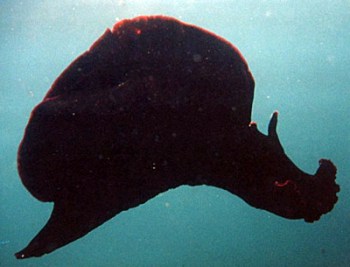
Aplysia fasciata
Poiret, 1789
Order: ANASPIDEA
Superfamily: APLYSIOIDEA
Family: Aplysiidae
DISTRIBUTION
Atlantic coast of France, Mediterranean, West Africa. Rare visitor to southern British Isles. See message [m12545] identifying this species from Brazil.
PHOTO
Baleal, Portugal, August 2001. Between 2 and 3 meters deep. Photo: João Pedro Silva.
Body black or very dark brown, sometimes with a red border to the parapodia, foot and cephalic tentacles. Sometimes some whitish blotches over body. The parapodial lobes are widely separated both anteriorly and posteriorly. Can grow to 40 cm long.
See Bebbington & Hughes (1973) for a description of swimming in this species.
Note: See message #12545 proposing that A. brasiliana is a synonym.
Reference:
• Bebbington, A. & Hughes, G.M. (1973) Locomotion in Aplysia (Gastropoda, Opisthobranchia). Proceedings of the Malacological Society, London, 40: 399-405.
Rudman, W.B., 2001 (February 21) Aplysia fasciata Poiret, 1789. [In] Sea Slug Forum. Australian Museum, Sydney. Available from http://www.seaslugforum.net/find/aplyfasc
Related messages
Re: Aplysia brasiliana = Aplysia fasciata?
February 13, 2009
From: Bill West
Concerning message #12545:
I had a question regarding A. fasciata. The ink they secrete, is it toxic to other organisms in an aquarium setting?
Locality: Red Reef Park West, 5 feet, Florida, United States of America, Atlantic Intracoastal, 08 February 2009, Low tide 3:00 PM Intracoastal Waterway. Length: 14
Bill West
chenoko@yahoo.com
West, W. D., 2009 (Feb 13) Re: Aplysia brasiliana = Aplysia fasciata?. [Message in] Sea Slug Forum. Australian Museum, Sydney. Available from http://www.seaslugforum.net/find/22243Dear Bill,
If you go to the General Topics List you will see there is a whole section of Sea Hare Topics including one on Ink Glands. Have look at it and the attached messages for some background information. You will see that they need to eat red algae to produce the purple ink. I suspect the ink is not toxic but it would be sensible to de-ink them before introducing them to an mixed aquarium by keeping them in isolation for a day or so and handling them a bit. If you then feed them on a green alga like Ulva [sea lettuce] they won't produce the ink. Some people feed sea hares with leaves of garden lettuce after quickly dipping it in boiling water. But anything you do is at your own risk.
Best wishes,
Bill Rudman
Variation in egg mass color in Brazilian Aplysia fasciata
July 10, 2008
From: Vinicius Padula
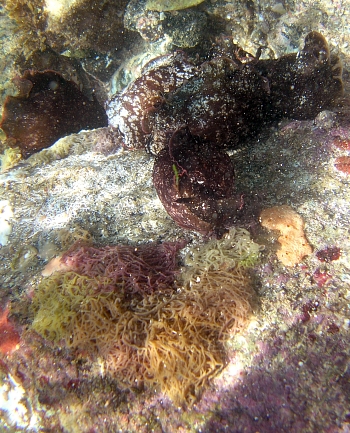
Concerning message #21693:
Dear Bill,
To accompany my message about egg colour in brazilian A. dactylomela [message #21695] here are pictures showing the color variation in the egg mass of Aplysia fasciata from Rio de Janeiro state, Brazil.
Locality: Conchas Beach, interitdal, Brazil, Western Atlantic. Photographer: Vinicius Padula.
Best wishes,
Vinicius
viniciuspadula@yahoo.com
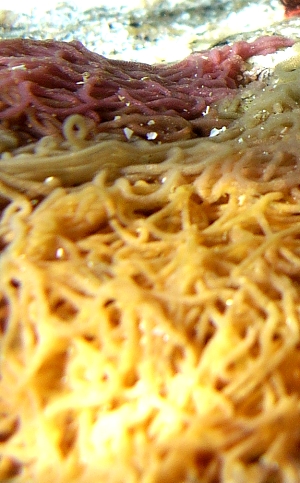
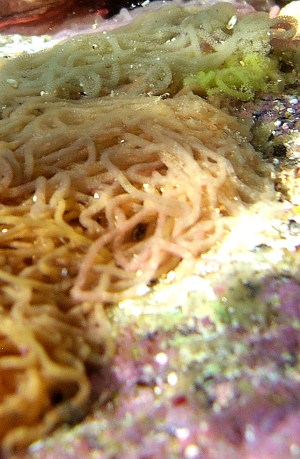
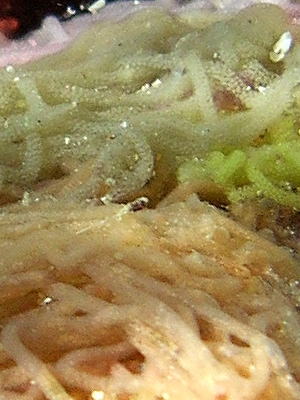
Thanks Vinicius,
Are the colour differences we can see in your photos entirely developmental? That is do they all start out pale cream colour then follow a sequence as they develop through perhaps dark yellow, green and pinkish red, or is there some variability in the colour of freshly laid eggs? Perhaps egg colour is diet related?
This is a nice example - but I am not sure what it is an example of!
Best wishes,
Bill Rudman
Aplysia fasciata from Portugal
July 2, 2008
From: Valter Jacinto
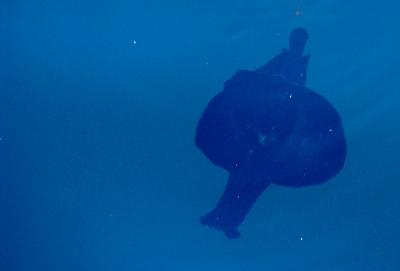
Hello!
Is this Aplysia fasciata???
Locality: Marina de Faro, Faro, 1 m, Algarve, Portugal, Atlantic Ocean - Ria Formosa, June 21, 2008, Marina. Length: 15-20 cm. Photographer: Valter Jacinto.
Thanks.
Valter Jacinto
valter@sapo.pt
Jacinto, V., 2008 (Jul 2) Aplysia fasciata from Portugal. [Message in] Sea Slug Forum. Australian Museum, Sydney. Available from http://www.seaslugforum.net/find/21653Dear Valter,
Yes this is most probably A. fasciata swimming.
Best wishes,
Bill Rudman
Sea Hares washed up in Devon, UK
April 9, 2008
From: Rob Benzies
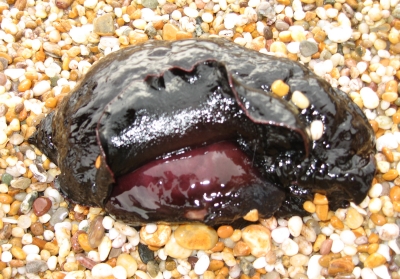
Found last week 2 red brown 7 inch long eliptical 4 inch wide jelly masses, on Slapton beach, Devon at low tide. Their back seemed to open up to reveal a similar smaller mass but pointing the other way and very tapered. The main mass was oozing in movement and had 2 snail like anterior antennae.
Surprisingly we found more days later in a state of decomposition - oozing a staining purple dye. I photographed the latter.
Locality: Slapton Beach, Devon, shoreline, England, Atlantic, 9 Oct 07, long shingle beach. Length: 7 in. Photographer: Rob Benzies.
Rob Benzies
robbenzies@aol.com
Benzies, R., 2008 (Apr 9) Sea Hares washed up in Devon, UK. [Message in] Sea Slug Forum. Australian Museum, Sydney. Available from http://www.seaslugforum.net/find/20973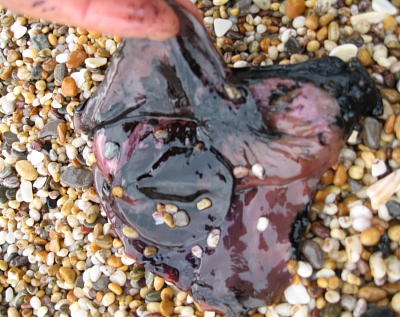
Dear Rob,
From your description and the photos your sad jelly masses were washed up Sea Hares. If you go to the Fact Sheet you will find quite a bit of background information. Have a look at the attached meesages for further information and links. I am pretty sure the species you found was Aplysia fasciata which can use the large flaps [ = parapodia] shown in your upper photo for swimming. The purple ink is a very characteristic feature of most sea hares. In some parts of the world sea hares can wash up in incredibly large numbers [see Mass Mortality Fact Sheet].
Best wishes,
Bill Rudman
Swimming sea slug in France
October 4, 2007
From: Tim Twibell
I am trying to identify a 'sea slug' (perhaps) I found in France. It was on the atlantic coast and stranded in the shallow waters, in land of a raised oyster bed, at a spring low tide.
It was about 2ft long, black, with large flapping 'wings' for swimming. I don't even know where to start in its identification. I am only guessing that it it a sea slug. Might manage a photo if it is a sea slug
Locality: France, west coast, 1ft, France, Atlantic, 28th sept 2007, intertidal, sandy. Length: 1.5 to 2ft
Tim Twibell
tim.twibell@marineturbines.com
Twibell, T., 2007 (Oct 4) Swimming sea slug in France. [Message in] Sea Slug Forum. Australian Museum, Sydney. Available from http://www.seaslugforum.net/find/20885Dear Tim,
One reason contributors send photos to the Forum is so we can identify their mystery animals. There are many tens of thousands of marine animals so a photo is always a useful start. Having said that, your mention of ' large flapping 'wings' for swimming ' may have solved the mystery.
I suspect your animal is a sea hare and most probably Aplysia fasciata. Have a look at the species Fact Sheet and some of the earlier messages attached to it. Some of them have photos of it swimming.
Best wishes,
Bill Rudman
Aplysia fasciata in western France
September 3, 2007
From: Michael Keys
Whilst on holiday on Ile de Re off the west coast of France we saw a large group of Aplysia fasciata. They were grouped in rock pools amongst natural oyster beds at low tide feeding on sea weed and sheltering under sea weed, apparently laying large quantities of noodle-like eggs.
A few were swimming in shallow water, and when the tide came in were also seen swimming freely in deeper water. Difficult to tell how many, but I guess more than 50. They were generally in small groups, some sheltering, some laying eggs, some grazing on sea weed, and a few swimming. No photos I am afraid.
A few local oyster fishermen seemed to know of them, but were not particularly interested. Our children were fascinated and handled a few very gently.
Locality: La Couarde, Ile de Re, 0 metres to 2 metres, France, Atlantic Ocean, 28 August 2007, Intertidal, oyster beds / rock pools. Length: 200-300 mm
Michael Keys
mk@feildenclegg.com
Keys, M.D., 2007 (Sep 3) Aplysia fasciata in western France. [Message in] Sea Slug Forum. Australian Museum, Sydney. Available from http://www.seaslugforum.net/find/20625Thanks Mike,
Bill Rudman
Swimming Aplysia in Portugal
August 20, 2007
From: Gary Leman
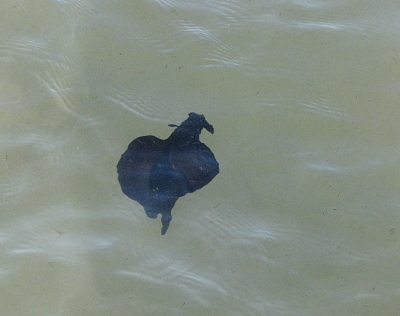
Location Portugal
Observed loads of these guys swimming to a 10 metre rocky location on a beach that was over 5 miles long. They only occupied the area for so long returning at the same time each day.
Locality: Armacoe de Pera, from intertidal to open ocean, Portugal, Atlantic, 10 August 2007, sandy bottom. Length: hand sized
How do they navigate ? How do they remember ?
I know that limited behavioural responses have been studied... like the nip reaction but after seeing these things they looked very intelligent.
At first I thought they were coming in on the tide to face a death by beaching, but after "rescuing" several.. each of them turned around and headed for the rocks again. All were eating seaweed on the rocks, but loose seaweed of the same type was washed up on the beach.
Anyone studied these movement patterns before ?
All comments gratefully received.
Gary Leman
garyleman@hotmail.com
Leman, G. P., 2007 (Aug 20) Swimming Aplysia in Portugal. [Message in] Sea Slug Forum. Australian Museum, Sydney. Available from http://www.seaslugforum.net/find/20469Dear Gary,
This is almost certainly Aplysia fasciata, which is often found swimming in groups at certain times of the year. We also have many messages concerning a species in the western Atlantic, A. brasiliana, which is almost certainly the same species. Have a look at the General Topics List which has a whole section on Sea Hares, including pages on swimming, mass mortality, and other aspects of their lives. You may also be interested in the 'love drug' [see message #19464] which is apparently a powerful attractant, although I don't know if pheromones would work well on open beaches like you describe here.
There were a couple of papers some years ago on navigation in swimming Aplysia which I have listed below. I don't know if any of that work has been followed up. Concerning the looking intelligent - I think it says something about our brains. When they stare at you with their soulful eyes some neuron in the most primitive part of our brain must fire - just remember, their eyes don't even form images, and the very simplicity of their 'brain' is why they are such a popular experimental animal with scientists studying how brains work.
-
Hamilton, P. V. and Russell, B. J. (1982) Celestial orientation by surface-swimming Aplysia brasiliana Rang (Mollusca: Gastropoda). Journal of Experimental Marine Biology and Ecology, 56: 145-152.
-
Hamilton, P. V. and Russell, B. J. (1982) Field experiments on the sense organs and directional cues involved in offshore-orientated swimming by Aplysia brasiliana Rang (Mollusca: Gastropoda). Journal of Experimental Marine Biology and Ecology, 56: 123-143.
Best wishes,
Bill Rudman
Unidentified Sea Slug from Spain
July 18, 2007
From: David Gilbert
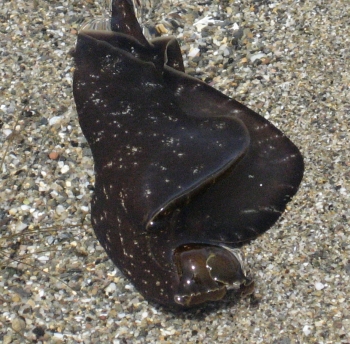
Hello Bill ,
I wonder if you could help please.Whilst on holiday in Spain i spotted these creatures.They were slowly swimming on the surface or seemed to be feeding right on the edge of a river.They were between 3 and 6" long and moved gracefully. None of the locals knew what they were! Any information or ID would be appreciated.
Locality: Puerto Banus , Marbella, Surface, Spain, Mediterranean, 24 May 2007, River which drained into the Med.. Length: 5 inches. Photographer: David Gilbert.
Regards,
David Gilbert
thegilbertsuk@aol.com
Gilbert, D.L., 2007 (Jul 18) Unidentified Sea Slug from Spain. [Message in] Sea Slug Forum. Australian Museum, Sydney. Available from http://www.seaslugforum.net/find/20134Dear David,
This is a Sea Hare, and the one you are most likely to find in Spain, swimming like this, is Aplysia fasciata. If you look at the earlier messages on this species you will see it is found all along the northern Mediterranean coast, and quite a few of the messages suggest the locals have never seen them - I guess it's because the holidaying visitors have more time to wander along enjoying the sights.
Best wishes,
Bill Rudman
Have I been poisoned?
July 17, 2007
From: Pete Baker
On June 7th, 2007 I was on the beach south of Athens, Greece. About 4 feet off the beach we found what looked to be a 10 inch long shell-less creature (the head resembled a snail) floating in the water. It's sides resembled wings as they rippled through the water. The creature was black (or at least very dark in color.) I briefly touched one of it's rounded wings (kinda shaped like a small frisbee with the tubular body in the middle.)
That night we boarded a plane for the US. I was feverish on the flights all the way home. By June 13th I was being admitted to the hospital with a BP of 76/50, a fever of 103.4, and severe dehydration. My lymphatic system went haywire and my white blood cell count was over 20,000. The doctors have no clue what I have and on reflection the only thing I can not account for is that sea critter.
Locality: Beach, Southern Athens, 1 meter, Athens, Greece, Aegean Sea, 08 June 2007, just offshore, public beach.. Length: 10 inches
Can someone shed some light on the subject?
Thanks in advance,
PBaker
pbaker2@gmail.com
Baker, P., 2007 (Jul 17) Have I been poisoned?. [Message in] Sea Slug Forum. Australian Museum, Sydney. Available from http://www.seaslugforum.net/find/20232Dear Pete,
I'm not sure how urgent your enquiry is but its quite easy to answer. Basically if you have been poisoned I don't think touching sea hares is a likely cause. From your description I suspect the animal you touched was probably the sea hare Aplysia fasciata. Have a look at some of the earlier message attached to that Fact Sheet and you will find photos of swimming animals. I can't give medical advice but I know of no ill effects caused by touching these animals. One species in Western Australia, Aplysia gigantea, can cause problems for dogs which bite or lick washed up animals, but that is noteworthy only because it the only sea hare worldwide which is reported to cause problems just by touch. Now and then people who eat them can become ill, but I don't think you fall into that category. If you go to the General Topics list on the Forum you will find a whole section on Sea Hares if you want to learn more about them. I hope you solve your illness
Best wishes,
Bill Rudman
Aplysia fasciata and A. punctata from Antibes
June 1, 2007
From: Dominique Horst
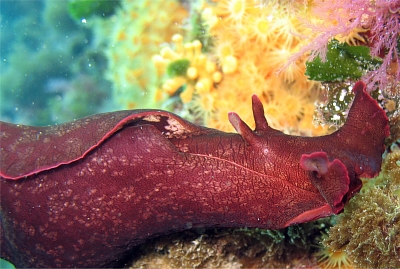
Dear Bill,
I have some doubt about the identification of these Aplysia. I think there are two species, first is A. punctata and the others are A. fasciata. My doubt come from the fact that they both have a red line on the border of the mantle and both are spotted even if the first one is largely more spotted even inside the mantle.
Also, on the picture of the couple, one is a partially spotted but not the second one.
Locality: Cap d'Antibes and Golfe-Juan, 15m, France, Mediterranean sea, 13 May, 2006 and 23 June 2006, vertical rock. Length: 250mm. Photographer: Dominique Horst.
Thanks a lot in advance for your continuous help.
Kind regards,
Dominique
dominique.horst@wanadoo.fr
Horst, D., 2007 (Jun 1) Aplysia fasciata and A. punctata from Antibes. [Message in] Sea Slug Forum. Australian Museum, Sydney. Available from http://www.seaslugforum.net/find/17002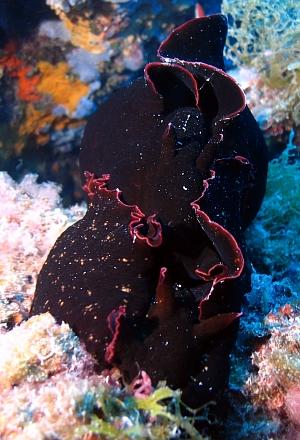
Dear Dominique,
I am pretty sure these are all A. fasciata. I don't think A. punctata usually has a red parapodial border. More importantly these two species are quite different in shape. A. punctata is one of a few species in which the parapodia join together quite high behind the mantle - shell region. Also the shell in A. punctata is usually partially visible through the large hole or 'foramen' in the mantle roof [see message #9758 ].
Aplysia fasciata on the other hand, is a swimming species, and the parapodia are large and quite separate from each other. In A. fasciata the 'foramen' is a small pore which is almost invisible.
Best wishes,
Bill Rudman
Aplysia fasciata from Greece
September 11, 2006
From: Hilary Cunliffe-Charlesworth
Appearance; dark brown with not markings
Swimming just under the surface, at midday, appearing to be grazing. In sight for about 5 mins, during which time it remained just under the surface, swimming very close to the boats. The 'wings' curled and uncurled. It could change direction at will and moved with considerable speed. Fish swam close, not bothered by its presence. It was just too far out from the quay to photograph. It was spotted by our daughter Helen, who called us to see a 'sea bat'. Our first sighting of one - we have sailed in the Ionian Sea for past 20 years. Thanks to your website for information.
Locality: Harbour, 10cm, Preveza, [by town quay] Greece, Mediterranean, 19 August 2006. Length: 28 cm aprox
Hilary Cunliffe-Charlesworth
h.cunliffe-charlesworth@shu.ac.uk
Cunliffe-Charlesworth, H, 2006 (Sep 11) Aplysia fasciata from Greece. [Message in] Sea Slug Forum. Australian Museum, Sydney. Available from http://www.seaslugforum.net/find/17638Dear Hilary,
Thanks for the record
Best wishes,
Bill Rudman
Aplysia fasciata? from the Canary Islands
August 21, 2006
From: Christian Kowalewski
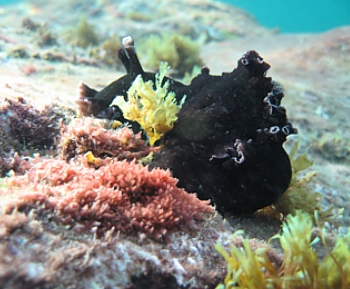
Hallo
I am not sure if this is Aplysia fasciata because a marine biology doctor tells me it is A. punctata. What do you think?
The picture is taken just below the intertidal in the same area as I often find A. dactylomela; rocky overgrown substrate during winter under rough waves.
Locality: Tenerife Island, Canary Islands, 2 meters, Spain, Atlantic Ocean, 16 May 2006, Under Intertidal, rocky overgrown . Length: 14 cm. Photographer: Christian Kowalewksi
Thanks
Christian Kowalewksi
moratorix@gmx.de
Kowalewski, C.J., 2006 (Aug 21) Aplysia fasciata? from the Canary Islands. [Message in] Sea Slug Forum. Australian Museum, Sydney. Available from http://www.seaslugforum.net/find/17375Dear Christian,
I hesitate to disagree with a local expert, but the animal in your photo certainly looks like A. fasciata to me. There certainly appears to be a reddish tinge to the end of the oral tentacles, and the edge of the parapodia also seem to have a reddish tinge, so in colour it fits A. fasciata. A more defining feature separating A. fasciata and A. punctata is that in A. punctata the posterior end of the parapodia join quite high. In your photo, the animal seems to have parapodia which remain open posteriorly, suggesting it is A. fasciata.
However if you look message #17503, which I am also posting today, I am pretty sure the animal there is A. punctata, despite the reddish parapodial border. Often these species cannot be identified by single photos. One sure way is to see if they swim. Aplysia fasciata, with parapodia which remain unjoined posteriorly, is a swimmer, while A. punctata which has the parapodia joined high up posteriorly, doesn't swim.
Best wishes,
Bill Rudman
Swimming Aplysia fasciata from Oeiras, Portugal
August 9, 2006
From: Ricardo Gomes Afonso
Hi. I'm Ricardo from Oeiras - Portugal. For all I could see in this site, I surely saw 3 Aplysia fasciatain Oeiras recreation harbour. It was at night, around midnight, a lot of families walking by. Suddenly I see some people talking with surprise: "what a hell is that... look at that thing", etc. Of course, I had to see it. What I saw was fascinating. It looked like a black little angel thing flapping its gracious wings, in a slow, wavy motion. Those animal were around 10 to 15 cm long.
One of the pleasures of Oeiras recreation harbour is being able to watch the fascinating sea life that lives around the big stones placed around the edge of the harbour. Schools of fish, swimming, jumping at the same time, jellyfish, little squid, sometimes octopus, crabs, and this superb Aplysia fasciata. I'm sorry I have no photos, but maybe one day I'll give it a shot. Just wanted to say how wonderful this animal is and that it's our important task in life to treat mother nature well, not just because of its beauty, but also because our own lives depend on it.
Locality: Near the mouth of the Tejo river with Atlantic, Surface, Portugal, Atlantic, 05 August 2006, Greenish water at the edge of a very well lit recreation harbour (midnight). Length: 10-15 mm
Ricardo Jorge Gomes Afonso
ricardogomes04@gmail.com
Afonso, R.G., 2006 (Aug 9) Swimming Aplysia fasciata from Oeiras, Portugal. [Message in] Sea Slug Forum. Australian Museum, Sydney. Available from http://www.seaslugforum.net/find/17366Dear Ricardo,
Swimming Aplysia are indeed a spectacular sight.
Best wishes,
Bill Rudman
Are those 3 all Aplysia fasciata ?
June 9, 2006
From: Stephane Ores
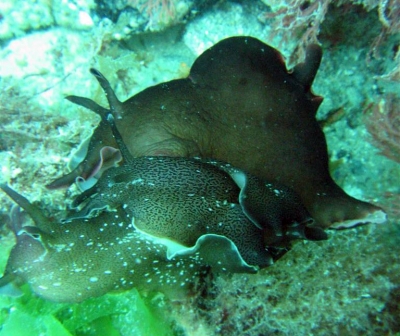
Dear Bill
I saw these guys mating, in Brittany. The one with the typical red edging is Aplysia fasciata, but the other don't have the typical red edging - are they from another species? (Aplysia punctata perhaps?), or is it possible for the typical red edging to be missing in A. fasciata?
Locality: St Cast, northern Brittany, France, 5 m, Brittany, France, Channel, Atlantic Ocean, 05 june 2006, Good visibility. Length: 200 mm. Photographer: Stephane Ores.
Thanks and best regards
Stéphane
stephane.ores@neuf.fr
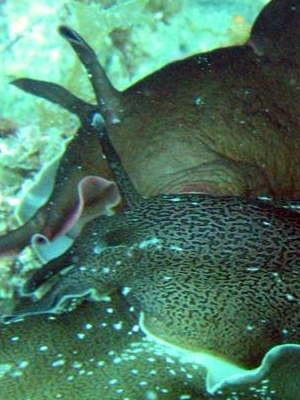
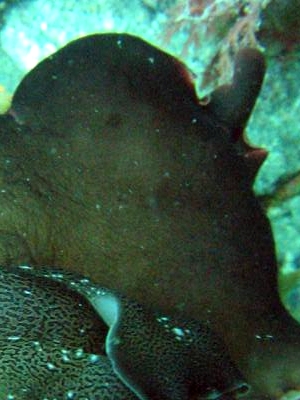
Dear Stephane,
Usually, species of Aplysia are easier to identify alive from aspects of their general body shape, than from photos. While the larger one, with red edging, is certainly A. fasciata, that species does not always have a red edging to the parapodia and head tentacles so the others could possibly be a colour form.
However I suspect they are, as you suggest, A. punctata. If you have a look at Marina Poddubetskaia's earlier message [#9758] you will see animals from Brittany, which from their shape are clearly A. punctata. It's not unusual at some times of the year to find mixed groups of mating Sea Hares. The environmental conditions which lead to mating in one species, cause similar effects in other species as well.
Best wishes,
Bill Rudman
Sea Hare from Cyprus
June 7, 2006
From: Helen Coombes
Today the children found a nudibranch that we have been unable to identify. It was dark brown with tiny cream speckles, was about 12 cm in length, and swam by using it "wings". It had two horns below which appeared to be tiny eyes. It had whisker like projections from its mouth. On its back was a bulbous lump which was concealed by its wings when it rested. At rest, with its wings held upright together on its back, it resembled a cornish pasty with an undulating, crimped edge to its wings! It also had a single tube coming out from its body, tail end.
Locality: Public beach, Limassol, 0.5 metres, Cyprus, Mediterranean, 29 May 2006, Clear water, some rocks, sandy bottom. Length: 12 cm
Helen Coombes
helencoombes@yahoo.co.uk
Coombes, H.J., 2006 (Jun 7) Sea Hare from Cyprus. [Message in] Sea Slug Forum. Australian Museum, Sydney. Available from http://www.seaslugforum.net/find/16733Dear Helen,
I am pretty sure your mystery animal was a Sea Hare, and most probably Aplysia fasciata. Have a look at the Fact Sheets and associated messages for more information on this fascinating group of sea slugs.
Best wishes,
Bill Rudman
Aplysia fasciata? from Sao Paulo, Brazil
March 16, 2006
From: Armando de Luca Jr
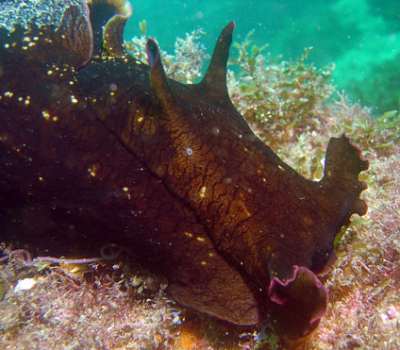
Hi Bill
Is this a Aplysia dactylomela? Very abundant in the months February and march. Size 25cm. Depth 18 to 20m. Water temperature : 21ºC. Site: Laje de Santos Marine State Park - Santos - Sao Paulo - Brazil.
Locality: Laje de Santos Marine State Park, 20m, Sao Paulo, Brazil, Atlantic Ocean, 27 february 2006, Rocky bottom. Length: 250mm. Photographer: Armando de Luca Junior.
Thanks
Armando de Luca Jr
mergulho@nautilusdive.com.br
de Luca, Armando, 2006 (Mar 16) Aplysia fasciata? from Sao Paulo, Brazil. [Message in] Sea Slug Forum. Australian Museum, Sydney. Available from http://www.seaslugforum.net/find/16118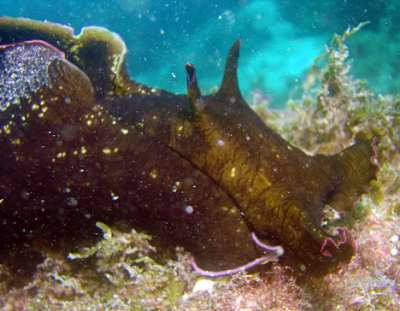
Dear Armando,
About this time in 2004 I posted a message [#12545] about some photos Vinicius Anderson sent from Rio de Janeiro which I suggested were probably of Aplysia fasciata, previously known only from the east Atlantic. I suggested that A. fasciata and A. brasiliana were probably the same species. Your photos show the typical red edging to the oral tentacles and parapodia, and the tips of the rhinophores. If you have photos showing the whole body they would be useful. I am slightly surprised that no one has commented on my suggestion considering how common A. fasciata and A. brasiliana are on their respective sides of the Atlantic.
Best wishes,
Bill Rudman
Aplysia fasciata in Portugal
January 28, 2006
From: Mark Williams
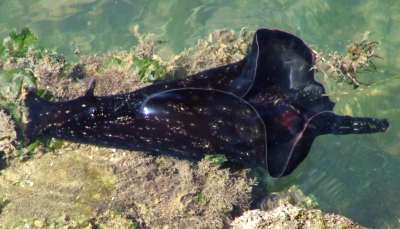
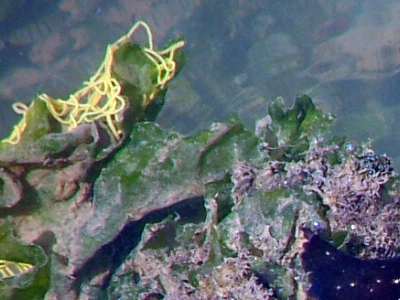
This animal was seen near the mouth of the river at Tavira, Algarve Portugal in may 2005. There were up to 10-12 of the animals close to the surface of the water and free swimming. they appeared to be feeding on algae.
Locality: Tavira, Algarve, sthn Portugal. At the surface. Length: 30 cm. 29 May 2005. River with freestone/sand bed. Photographer: Mark Williams
Can you tell me what they are?
Mark Williams
mark.williams27 @btinternet.com
Williams, M., 2006 (Jan 28) Aplysia fasciata in Portugal. [Message in] Sea Slug Forum. Australian Museum, Sydney. Available from http://www.seaslugforum.net/find/15666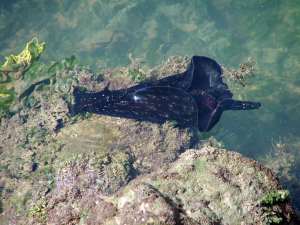
Dear Mark,
This is a Sea Hare, almost certainly Aplysia fasciata which is apparently quite common swimming on the coasts of Portugal and certain times of the year. Like most sea slugs, it usually crawls on the bottom, but many Sea Hares use their large wing-like parapodia to swim, especially when they are disturbed, or swept off the bottom by waves or currents. They feed on certain red and green algae [sea weeds]. I have included a close-up of part of your photo to show the yellow spaghetti-like egg ribbon on the green algae. This is almost certainly the egg ribbon of Aplysia fasciata.
Best wishes,
Bill Rudman
A swimming Sea Hare from Brittany
December 5, 2005
From: Kate Bryant
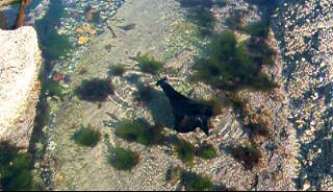
I came across a Sea Hare in a rock pool off the Southern coast of Brittany, France on the 10th September 2005. It was about 30 cms in length and appeared Black but on closer inspection was a very deep blue. It swam across the rock pool extending it's length by about another 6cms. It was quite happy grazing on the green vegetation in the pool.
Locality: Fort Bloqué, France. Atlantic. Depth: 0 - 30 cms. Length: 30 cms. 10 September 2005. clear rock pool. Photographer: Kate Bryant
I have searched your website but can find no Sea Hare of a similar proportion and colour. I would be interested to know it's full family name and how common is it to find one in a rock pool.
Kate Bryant
bryantk2@wanadoo.fr
Bryant, K., 2005 (Dec 5) A swimming Sea Hare from Brittany. [Message in] Sea Slug Forum. Australian Museum, Sydney. Available from http://www.seaslugforum.net/find/15396Dear Kate,
This is almost certainly Aplysia fasciata. Many black slugs get a bluish sheen over them which is caused by a trick of light, the nature of which I have had explained to me but unfortunately forgotten. As you will see if you browse through some of the earlier messages on this species, it is a common swimming Sea Hare in Europe
Best wishes,
Bill Rudman
Re: Aplysia fasciata in Spain
October 14, 2005
From: Job Tammens
Dear Bill,
They're back !!!
After we've seen the last couple in 2002 [message #8514], we saw lots of them this year on the beach of Peñiscola - Spain. They were very small ones, from about 8 to 12 cm's long. Probably they were coming ashore with a lot of seaweed after a large storm in the Mediterranean.
Locality: Peñiscola, Spain. Mediterranean Sea. Length: 8 to 12 cm. September 2005. washed up on sandy beach.
I salvaged a couple of shells from some of them that got killed on the sandy beach. I'll try and take some decent pics and place these in short time.
Regards,
Job Tammens
Groningen - The Netherlands
job@cadgwith.com
Tammens, J.G.K.F., 2005 (Oct 14) Re: Aplysia fasciata in Spain. [Message in] Sea Slug Forum. Australian Museum, Sydney. Available from http://www.seaslugforum.net/find/14981Dear Job,
Thanks for keeping us up to date. I guess they are there every year, but storms, and their life cycle doesn't always coincide with your visits.
Best wishes,
Bill Rudman
Swimming Aplysia fasciata from Portugal
September 17, 2005
From: John Richardson
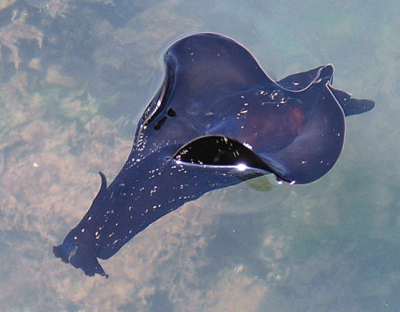
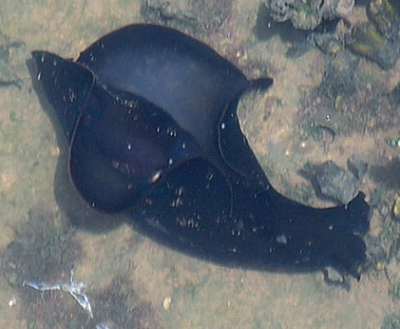
After months of trying to identify this species I found your site and almost certainly this is Aplysia fasciata, sea hares. First saw them at night near an illuminated bridge - weird black shapes moving through the water. About 20 - 30 stayed around this location for a couple of days after. Never seen them here before - are they on the increase, or moving in due to glabal warming?
Locality: Tavira, Algarve, Portugal. Depth: 0 - 1 meter. Length: 25 - 30 cm. 1 june 2005. Tidal river, 1.5 km inland Photographer: John Richardson
John Richardson
john.r@btinternet.com
Richardson, J., 2005 (Sep 17) Swimming Aplysia fasciata from Portugal. [Message in] Sea Slug Forum. Australian Museum, Sydney. Available from http://www.seaslugforum.net/find/14775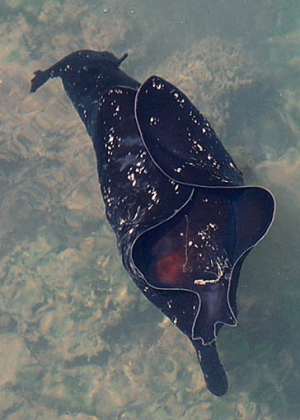
Dear John,
Yes this is Aplysia fasciata. Silent, swimming Aplysia do seem somewhat ominous. Here at the museum in Sydney, we have great flights of large fruit bats which emerge from the nearby Botanical Gardens at dusk. Their silent methodical flapping of wings creates a very similar impression. I don't think there is any evidence to suggest Sea Hares are increasing in numbers anywhere. Some years there may be many at a particular spot, while in others there may be none. As they have free swimming microscopic larvae, there is always a great element of chance involved in just where large populations will appear each year. Have a look at the mass mortality Fact Sheet for many examples of Sea Hares in great 'congregations'.
Best wishes,
Bill Rudman
Swimming slug from France
August 26, 2005
From: Robyn Mason-Holt
On Friday 19th August during our holiday in the south west of France (near La Rochelle) at low tide on a sandy beach, that shelved steeply to reveal a small 4 x 10 m rock pool area, we found a large black/red blob.
Locality: La Roche Plage (beach), Nr Jard sur mer, Vendee, France. Atlantic ocean. Length: 300 mm. 19 August 2005. Intertidal shallow rock pools.
Thinking it was an anenome we continued searching the rock pools and found another blob, just out of the water looking very dry and contorting itself. I knocked it gently in to the water to find it unwrapped itself and there swimming magestically in the pool was what i can only describe as a large 30cm long slug with wings. We saw another four within a 4 meter sq area. Unfortunately we had no camera with us so identifying them is proving difficult.Was it a Gastropteron and if so what species?
Thanking you in anticipation
Robyn.
simon@holts0.freeserve.co.uk
Mason-Holt, R.G., 2005 (Aug 26) Swimming slug from France. [Message in] Sea Slug Forum. Australian Museum, Sydney. Available from http://www.seaslugforum.net/find/14631Dear Robyn,
From its size it is unlikely to be a Gastropteron. Although the European Gastropteron rubrum is a great swimmer, it is only about one tenth of the size you describe. I guess your animals were a species of Sea Hare. The most likely species would be Aplysia fasciata which is a well-known swimmer, and can have red edging to its 'wings' [parapodia], foot and head tentacles. If you look at some of the messages concerning that species on the Forum you will see photos of it swimming.
Best wishes,
Bill Rudman
Re: Swimming Slug from Greece
July 25, 2005
From: Graham Smith
Concerning the above message [#13540] - Are these creatures poisonous ?My friend has just returned from Corfu and her son had something similar wraped round his finger and has left a nasty rash
Graham
grahamsporsche@hotmail.com
Smith, G., 2005 (Jul 25) Re: Swimming Slug from Greece. [Message in] Sea Slug Forum. Australian Museum, Sydney. Available from http://www.seaslugforum.net/find/14308Dear Graham,
It's most unlikely that it would cause an irritation - although with allergic reactions it is impossible to be definite, as particular people can have a reaction to the most seemingly benign objects. I know of no reports that Meditteranean species of Sea Hare cause any harm to humans - although one of the Ancient Greek writers, Aristotle I think, warned that touching them could cause death. The only species which is reported to cause problems, by touching, is the large Western Australian species Aplysia gigantea. If you look at the messages attached to the Fact Sheet for that species you willl see a number of messages on the topic.
Best wishes,
Bill Rudman
Swimming Aplysia from Greece
April 20, 2005
From: K. Tzouvali, D. Pettas
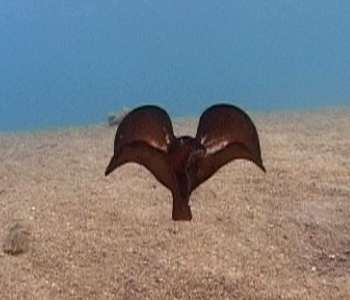
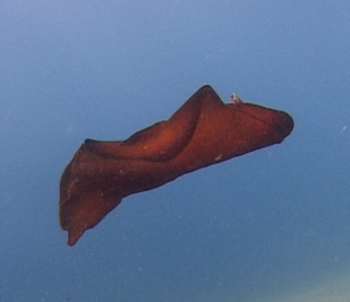
Dear Bill,
We would like to have your help for the identification of a sea slug. We think that it is Aplysia fasciata. It was flying full of determination and grace five meters under the surface for long distance. The flight of this animal is a part of its way of leaving. We have seen this slug scanning a big area on the bottom by moving with small flights from one place to another ten meters further.
Locality: Panagopula beach near Patras, Greece. Mediterranean sea. Depth: 5 m. Length: 300 mm. 8 October 2004. Photographer: K. Tzouvali, D. Pettas
The first time we found Aplysia it moved from our hands to a point on a net six meters further and higher from the place we were standing. We had picked it up some minutes earlier to examine it from the same pint on the net. Unfortunately, on the last two occasions we saw it, we had no camera with us, since we were working in checking the nets in a fishfarm.
Thanks in advance,
Katerina Tzouvali & Dimitris Pettas
Seawatch underwater video
seawatch@mes.forthnet.gr
Tzouvali, K. & Pettas, D., 2005 (Apr 20) Swimming Aplysia from Greece. [Message in] Sea Slug Forum. Australian Museum, Sydney. Available from http://www.seaslugforum.net/find/13540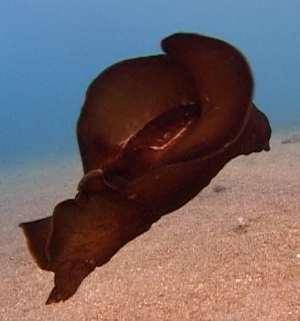
Dear Katerina and Dimitris,
Yes this certainly looks like A. fasciata. It's interesting to see you described its movement as 'flight' rather than 'swimming'. It certainly looks more like the flight of a bird than the swimming of a fish. Your comments on it using its swimming ability as a complement to crawling, to explore a larger arean is also valuable as we tend to think swimming in Sea Hares is used mainly as an escape mechanism or in larger scale movement over long distances.
Best wishes,
Bill Rudman
Happy New Year
December 31, 2004
From: Elif Özgür
Dear Bill
Thank you for your quick reply and your enlightening forum.
I wish happy New Year to you and all of the participants of the Forum.
Thanks for the all time and work you spent for the Sea Slug Forum.
Best Wishes,
Elif Özgür
eozgur@istanbul.edu.tr
Özgür, E., 2004 (Dec 31) Happy New Year. [Message in] Sea Slug Forum. Australian Museum, Sydney. Available from http://www.seaslugforum.net/find/12854Swimming Sea Hare from Turkey
December 29, 2004
From: Elif Özgür
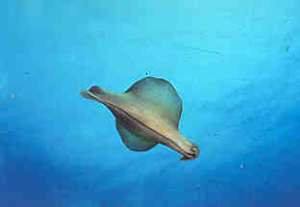
Is it possible to identifiy this species from the photo? It was photographed in Turkey, Mediterranean Sea
Elif Özgür
eozgur@istanbul.edu.tr
Özgür, E., 2004 (Dec 29) Swimming Sea Hare from Turkey. [Message in] Sea Slug Forum. Australian Museum, Sydney. Available from http://www.seaslugforum.net/find/12835Dear Elif,
This is a swimming Sea Hare. It is difficult to be sure of the species but it is most probably Aplysia fasciata. Have a look at the Fact Sheet on swimming in Sea Hares for further information.
Best wishes,
Bill Rudman
Aplysia fasciata? from Rio de Janeiro
March 25, 2004
From: Vinicius Padula Anderson
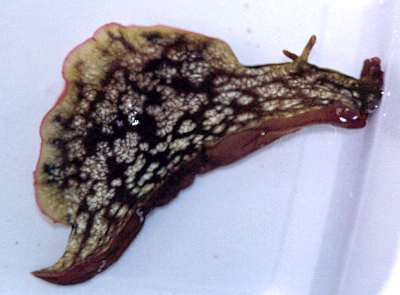
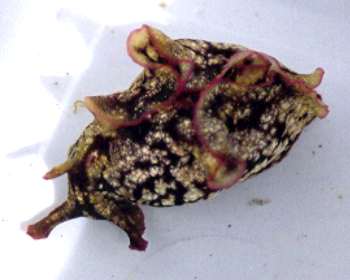
Hi Bill,
I send to the Forum these photos of another Aplysia from Conchas Beach, Rio de Janeiro state, Brazil.
I don´t know what species it is. I think it is Aplysia brasiliana, but I´m not sure. At the same locality there were lots of similar individuals but they are were more white or totally black. Are the same species?
I saw an yellow egg mass to.
Date: February 2004
Location: Conchas Beach, Cabo Frio, Rio de Janeiro, Brazil
Depth: 2 meters
Size: ~15cm
Best wishes,
Vinicius Padula
viniciuspadula@hotmail.com
Anderson, V., 2004 (Mar 25) Aplysia fasciata? from Rio de Janeiro. [Message in] Sea Slug Forum. Australian Museum, Sydney. Available from http://www.seaslugforum.net/find/12499Dear Vinicius,
This is an extremely interesting find. If you had said it was from the Atlantic coast of Europe, or West Africa, I would have had no doubt identifying it as Aplysia fasciata. For example it is very similar in colour to Joao Pedro Silva's photos [#9815] from Portugal, except for the presence of a red parapodial border. However specimens of Aplysia fasciata often have a red parapodial border and as far as I can find, the west Atlantic equivalent species, Aplysia brasiliana, has not been reported to have a red or pink border.
I have checked the literature and no one has reported Aplysia fasciata from the western Atlantic. I would be very interested in seeing photos of some of the other colour forms you saw at the same locality. I have discussed the identity of this animal more fully in a separate message [#12545], but basically it suggests that A. brasiliana and A. fasciata are populations of one amphiatlantic species.
Best wishes,
Bill Rudman
Aplysia brasiliana = Aplysia fasciata?
March 25, 2004
From: Bill Rudman
Vinicius Anderson's photos [#12499] of an aplysiid from Brazil, is convincing evidence that the eastern Atlantic species, Aplysia fasciata, also occurs in the west Atlantic. The corollary of that is that Aplysia brasiliana should be considered a west Atlantic population of Aplysia fasciata, as the only real difference between the two 'species' is their geographic distribution.
The anatomy of Aplysia brasiliana [see Eales, 1960; Marcus & Marcus, 1955] shows no significant differences to that of A. fasciata [see Thompson, 1976] in general shape, reproductive anatomy, radula morphology or nature of the mantle glands. Of particular relevance is a laboratory study of intra-specific mating between A. fasciata and A. brasiliana [see Susswein et al., 1993] which showed that in mating behaviour the two 'species' acted as though they were a single species. From published work on the larval biology of Aplysia, and on many amphiatlantic species, the authors considered that the evidence strongly suggested that A. fasciata and A. brasiliana were east Atlantic and west Atlantic populations of the one species. The presence sometimes of a pinkish red border to the parapodia, was the only real character separating the east Atlantic population from the west Atlantic population. The presence of a red-lined individual in Brazil clearly removes this last distinction. If my proposal is accepted, the oldest name for this species is Aplysia fasciata.
• Eales, N.B. (1960) Revision of the world species of Aplysia (Gastropoda, Opisthobranchia). Bulletin of the British Museum (Natural History), Zoology, 5(10): 267-404.
• Marcus, Ev. & Marcus, Er. (1955) Sea-hares and side-gilled slugs from Brazil. Boletim do Instituto Oceanografico, 6(1-2): 3-48.
• Marcus, Ev. & Marcus, Er. (1957) Notes on Aplysia. Boletim do Instituto Oceanografico 8(1-2): 3-22.
• Marcus, Ev. (1972) On the Anaspidea (Gastropoda: Opisthobranchia) of the warm waters of the western Atlantic. Bulletin of marine Science, 22(4): 841-874.
• Susswein, A.J., Markovitch, S. & Achituv, Y. (1993) Asymmetry of male and female mating in mixed-species groups of Aplysia fasciata Poiret and Aplysia brasiliana Rang (Mollusca: Gastropoda). Israel Journal of Zoology, 39: 213-229.
• Thompson, T.E. (1976) Biology of opisthobranch molluscs. Vol. 1. Ray Society no. 151, London. 207 pages. (21 Pls.)
• Wirtz, P. (1998) Opisthobranch Molluscs from the Azores. Vita Marina, 45(1-2): 1-16
Best wishes
Bill Rudman
Sea Hare? swimming
January 6, 2004
From: A. Agnost
I just (a couple of hours ago - 30 December 2003) saw a sea creatures which I have not seen before in my 57 yrs of life in Greek waters!
My immediate reaction was to search the web (of course). The closest I could find was the pix you have on this site. However the creature I saw was swimming slowly but deliberately right below the surface of the water, waving its winglike membranes like bat wings only much more gracefully; every so often it would stick its head a tiny bit out of the water. It had a round (almost pregnant looking) body. Its wings seemed to be fixed below this round body. Its neck would "stick" out of the winged part about 8-10 centimeters. It had a little "tail" section, about one or two centimeters beyond the end of its wings and it seemed to have two little tiny feet at the back with a tiny (third) one in the middle like a little tail. It was excreting some substance occasionally and it was definitely looking (or turning toward) at me as I was watching it. Its long neck was very flexible and agile.
So what do you make of it? I have been diving and snorkeling almost as far back as I can remember in these waters and have never seen anything like it ! Its color was dark brown almost black. Unfortunately no camera was available at the time!
The pictures in your article appear to be something like it only the one I saw was not wrapped up and did not have any spots. I would appreciate any info on the subject.
I'll go back with a camera, see if it would still be around. Who knows, maybe it is looking for a place to lay eggs (?).
Thanks
A. Agnost
tmgp2000@yahoo.com
Agnost, A., 2004 (Jan 6) Sea Hare? swimming. [Message in] Sea Slug Forum. Australian Museum, Sydney. Available from http://www.seaslugforum.net/find/11777Dear M. Agnost,
Your animal sounds like it was a Sea Hare swimming. The most likely one would be Aplysia fasciata. If you scroll down the messages you will find quite a few with photos of this species swimming, including a message from Greece. I also discuss some of the reasons they sometimes swim in another message. Photos are always welcome.
Best wishes
Bill Rudman
Andalucian sea creature
November 17, 2003
From: Peter Stanford
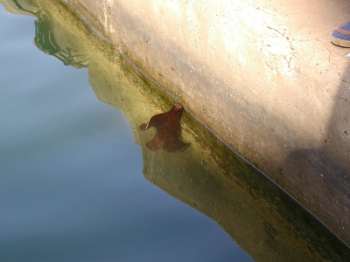
Please can you help identify this sea slug?? spotted in Almerimar harbour, Almeria, in southern Spain.
Peter Stanford
peter@stanford47.freeserve.co.uk
Stanford, P., 2003 (Nov 17) Andalucian sea creature. [Message in] Sea Slug Forum. Australian Museum, Sydney. Available from http://www.seaslugforum.net/find/11421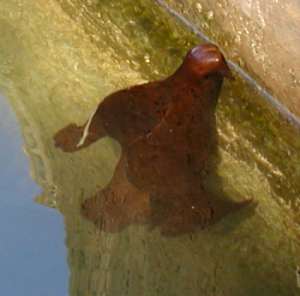
Dear Peter,
Your slug is a Sea Hare and almost certainly Aplysia fasciata. If you scroll down the page and look at the other messages on this species, you will see quite a few with photos of it swimming
Best wishes
Bill Rudman
Re: Aplysia fasciata from Cape Verde Islands
September 24, 2003
From: Gérard Breton
Hello Bill,
Many thanks for the ID and the comments on my Cape Verde sea slugs. Concerning Aplysia fasciata, I must confess that I did not see the odd "bubbles" in the living animal, and I found them when dispaying the photo!
Gérard
gerard.breton@ville-lehavre.fr
Breton, G., 2003 (Sep 24) Re: Aplysia fasciata from Cape Verde Islands. [Message in] Sea Slug Forum. Australian Museum, Sydney. Available from http://www.seaslugforum.net/find/11019Dear Gérard,
It's amazing how often our photos show things we didn't see at the time. I'm still puzzled by the lumps on your Aplysia.
Best wishes
Bill Rudman
Aplysia fasciata from Cape Verde Islands
August 20, 2003
From: Gérard Breton
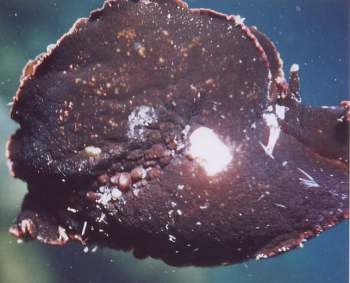
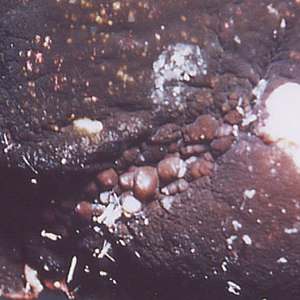
Dear Bill,
Here is another message from my dive trip between 22 - 30 March 2003 to two islands of the Cape Verde archipelago: Sal and Fogo.
Here is Aplysia fasciata from Fogo, Salinas (a natural harbour with abundant and diverse seaweeds). It was swimming (which is why it is unfortunately decapitated in my photo). It seems, under the right parapodia, to have two kinds of parasites (that I had not seen in the water): short copepodes and other ones, very long, needle-like: what can they be ?
Gérard
Gerard.Breton@ville-lehavre.fr
Breton, G., 2003 (Aug 20) Aplysia fasciata from Cape Verde Islands. [Message in] Sea Slug Forum. Australian Museum, Sydney. Available from http://www.seaslugforum.net/find/10749Dear Gérard,
Concerning the possible parasites - I don't recall seeing anything like this before, and I'm afraid there is not enough detail to be sure what I am looking at. The white rod-like bits could easily be broken bit of coralline algae or even sea-urchin spines but the large greyish 'blobs' could be an unwelcome visitor. Did you observe them in the living animal or did you 'find' them in your photo. I would be interested to know if your saw them moving around
Best wishes,
Bill Rudman
Re: Aplysia from Mediterranean France
July 21, 2003
From: Marina Poddubetskaia
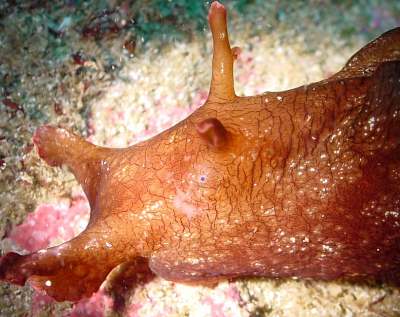
Dear Bill,
You are confirming my thoughts. The animal from Cerbere seems to me very similar to the pale colour form of A. fasciata photographed in Senegal. Moreover, the dark colour form of A. fasciata has already been seen in Cerbere in previous years.
The attached photo is of the paler animal which was mating with the darker, from Senegal.
Cheers,
Marina.
nembro@nembro.info
Aplysia from Mediterranean France
July 19, 2003
From: Marina Poddubetskaia
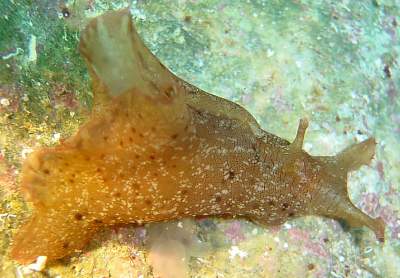
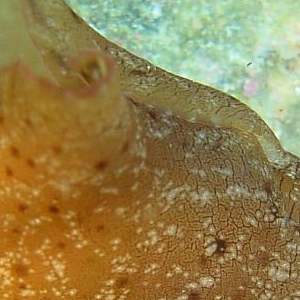
Dear Bill,
Re m10481
Here is an Aplysia from Cerbere to accompany my message about A. punctata. Is it also Aplysia punctata? I am a bit confused by its pale red border to the parapodia. Your opinion is very welcome.
Location : Cerbere, France, Mediterranean coast
Date: July 09, 2003
Site: L'Abeille
Depth: 9m
Size: 65-70mm
Photo: Marina Poddubetskaia - Nembro website
Cordially,
Marina.
nembro@nembro.info
Poddubetskaia, M. , 2003 (Jul 19) Aplysia from Mediterranean France. [Message in] Sea Slug Forum. Australian Museum, Sydney. Available from http://www.seaslugforum.net/find/10487Dear Marina,
If you look at the parapodia you will see they join very low down at the back of the body. This is quite different from the very high join in A. punctata. This feature, combined with the reddish parapodial border suggest that this is Aplysia fasciata.
Best wishes,
Bill Rudman
Aplysia fasciata: 2 colour forms from Senegal
June 27, 2003
From: Marina Poddubetskaia
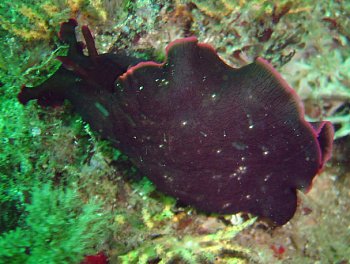
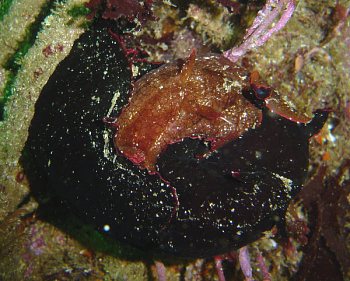
Dear Bill,
Aplysia fasciata is very common in Madeleine Isles, near Dakar. There are 2 colour forms of this species here: a dark one and a pale one.
In the second photo you can see these colour forms mating. When I found them I didn't know they were mating, but when I took the pale animal aside I saw I disturbed them.
In the third photo there is an animal burrowed under the sand. I didn't know this behaviour in Aplysia. Why do they do it? When I took this photo there was heavy surge.
Photos 1 and 2 :
Date: June 07, 2003
Location: Dakar, Senegal, Eastern Atlantic
Site: Fayis (Iles Madeleine)
Depth: 18-19m
Size:
(1) 14-15cm
(2) 15-16cm
Photo 3:
Date: May 31, 2003
Location: Dakar, Senegal, Eastern Atlantic
Site: Iles Madeleine
Depth: 11m
Photos: Marina Poddubetskaia - Nembro website
Best wishes,
Marina.
nembro@nembro.info
Poddubetskaia, M., 2003 (Jun 27) Aplysia fasciata: 2 colour forms from Senegal. [Message in] Sea Slug Forum. Australian Museum, Sydney. Available from http://www.seaslugforum.net/find/10213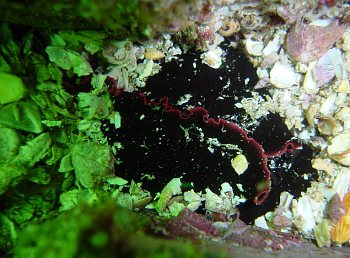
Thanks Marina,
Your observations certainly demonstrate that these two quite distinct colour forms are one species. There are some other observations on Sea Hares burrowing on the Forum. It seems to be a protective behaviour, but I don't think it has been much researched.
Best wishes,
Bill Rudman
Juvenile of Aplysia fasciata from Senegal
June 27, 2003
From: Marina Poddubetskaia
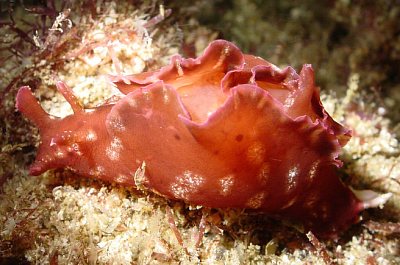
Dear Bill,
Here is another Sea Hare from Senegal. I think it is a juvenile of Aplysia fasciata because the red border to parapodia and oral tentacles can be seen well.
Date: June 04, 2003
Location: Dakar, Senegal, Eastern Atlantic
Site: Gouye teni M'bot
Depth: 23m
Size: 75-80mm
Photos: Marina Poddubetskaia - Nembro website
Best wishes,
Marina.
nembro@nembro.info
Poddubetskaia, M., 2003 (Jun 27) Juvenile of Aplysia fasciata from Senegal. [Message in] Sea Slug Forum. Australian Museum, Sydney. Available from http://www.seaslugforum.net/find/10214Dear Marina,
I'm sure you are right with your identification. The way the parapodia stay separated right to the back of the body is probably another useful character.
Best wishes,
Bill Rudman
Aplysia fasciata from Israel
May 6, 2003
From: Bella Galil
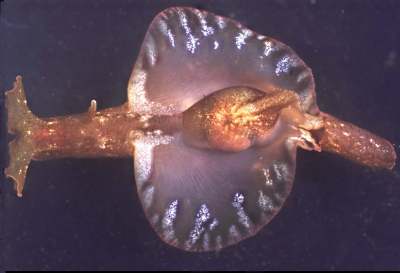
This unidentified Aplysia was collected in March 2003 near Haifa, on the Mediterranean coast of Israel. The specimen was photographed but not preserved. I wonder if you can help with identification.
Bella Galil
bella@ocean.org.il
Galil, B., 2003 (May 6) Aplysia fasciata from Israel. [Message in] Sea Slug Forum. Australian Museum, Sydney. Available from http://www.seaslugforum.net/find/9818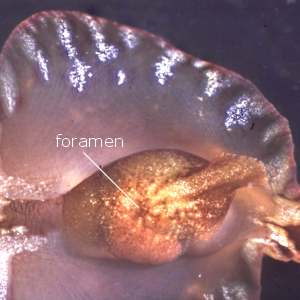
Dear Bella,
This is Aplysia fasciata. It has large parapodia which are often used for swimming. It is quite variable in colour but there are traces of a red edge to the parapodia, which is sometimes found in this species. I recently desribed the large mantle foramen in Aplysia punctata. Your photo gives me the opportunity to compare it with the small foramen in A. fasciata. I suspect in this photo that it is so contracted, that it is in fact constricted into a small papilla.
Best wishes,
Bill Rudman
Mottled Aplysia fasciata swimming
May 3, 2003
From: Joao Pedro Silva
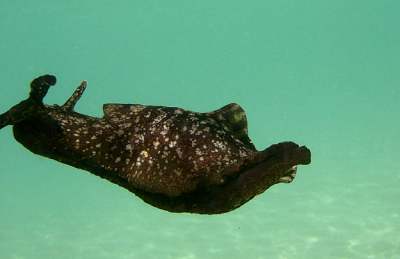
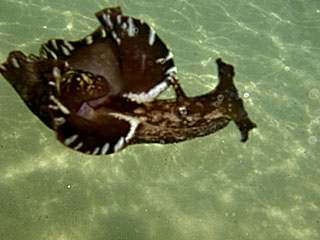
Dear Bill,
In previous messages I've sent you photos of Aplysia fasciata. These are mostly dark brown, even black, with a thin red or orange line on the edges of the parapodia. Last saturday I found this Aplysia fasciata swimming as I returned from diving. I asked my wife to get the digital camera. Unfortunately, the photos didn't come out very good and some are even out of focus. Anyway, here are a few samples for the record.
Best regards,
Joao Pedro Tojal Loia Soares Silva
jpsilva@uwphotographer.net
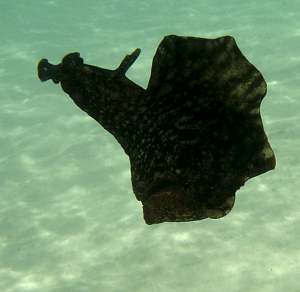
Dear Joao Pedro,
As with Marina Poddubetskaia's messages concerning colour variation in Aplysia punctata, your photos of the colour variation in A. fasciata helps give us a fuller appreciation of its variability. Although ungainly, swimming Sea Hares are a fascinating sight.
Thanks
Bill Rudman
Re: Aplysia fasciata in Spain
November 27, 2002
From: Job Tammens
Dear Bill,
Another addition to my other messages might be of interest. The first time in September to October 2000 we saw a couple of hundred seahares. The same time in 2001 there were maybe 30 to 40 of them and this year only 4 and two dead ones.
Best wishes,
Job Tammens and Cisca Dekker
job.tammens@12move.nl
Tammens, J., 2002 (Nov 27) Re: Aplysia fasciata in Spain. [Message in] Sea Slug Forum. Australian Museum, Sydney. Available from http://www.seaslugforum.net/find/8514Thanks Job & Cisca,
AS you will have seen in the messages where swarming and mass mortality is discussed, these events are quite normal, but the number of animals dying and the actual time the event will vary from year to year.
Best wishes,
Bill Rudman
Swimming Aplysia fasciata (2)
November 22, 2002
From: Job Tammens and Cisca Dekker
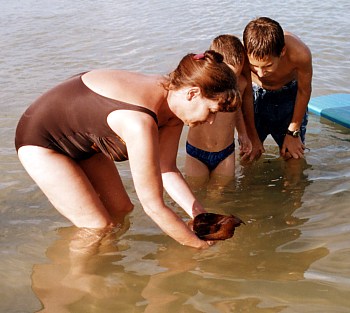
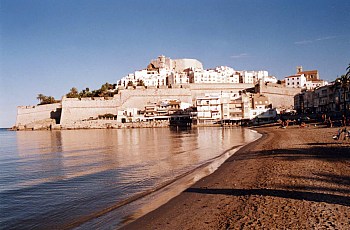
Dear Bill,
Thanks for your answer to our message. Here are two more pictures. The first attached foto shows my very brave girlfriend Cisca showing some local boys that it¹s completely harmless and therefore it¹s not necessary to hit them with everything available!!! It looks like they got the message. The second one is just to show you that seahares maybe appreciate a beautiful surrounding?!
Can you tell us what the two little black points in the neck are? I hope you enjoy the pictures and maybe next year we can send you some more.
Kind regards,
Job Tammens and Cisca Dekker.
job.tammens@12move.nl
Tammens, J. and Dekker, C., 2002 (Nov 22) Swimming Aplysia fasciata (2). [Message in] Sea Slug Forum. Australian Museum, Sydney. Available from http://www.seaslugforum.net/find/8477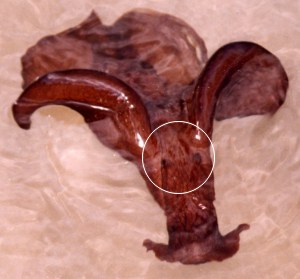
Dear Job & Cisca,
Thanks for the photos. It certainly looks a beautiful spot to be a sea slug - except when small boys are on the prowl. Concerning the black spots you ask about. Sea Hares have two pairs of head tentacles - one pair, the oral tentacles, are clearly visible at the front of the head. The black spots, are the second pair, called rhinophores, which are set further back on the head. They usually are quite prominent and upright, but when out of water or constantly in and out of water, as they would be when swimming like this, they contract into small lumps. Have a look at the photos on the Aplysia parvula page to see the shape of the head more clearly. In those photos you will see a little black spot just in front of each rhinophore. That is the eye. It can't see images, only light and dark. Your Sea Hares are blissfully unaware of their beautiful surroundings - except for what they can feel with the oral tentacles and smell with their rhinophores.
Best wishes,
Bill Rudman
Swimming Aplysia fasciata from Spain
November 20, 2002
From: Job Tammens
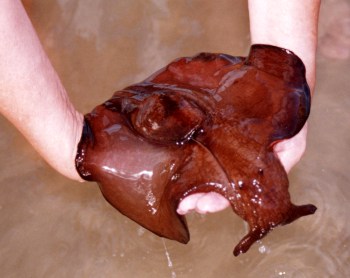
Dear Bill,
Here some pictures of a swimming Sea Hare from a sandy beach on the Mediterranean coast of Spain. I have seen lots of them in the last three years during my annual visits. Before then I had never seen any, which is very strange, because I'm a regular visitor. They are brown to almost black in color and their size varies from 15 to ca. 35 cm. I haven't seen any of this Mediterranian type on the Forum so I hope these pictures can be of some help.
The photo's were taken at the beach of a small town called Peñiscola, roughly 120 km north of Valencia and 230 km south of Barcelona. It is one of the most important monuments of Spain. The sixty's movie "El Cid" with Charlton Heston and Sophia Loren was shot here. The conditions in the last week of September 2002, when we took these photos was sunny, about 28 °C, water temperature about 18 °C. and hardly any wind.
When we first found them three years ago we didn’t have a clue what they were except for a seaslug. Also the locals had no idea, mostly they were panicking and calling it “Medusa” (jellyfish). A lot of them were already dead and lying on the beach rolled up looking very much like a grilled pigeon. The ones that were still in the water we tried to save by bringing them in deeper water and directing them to open sea. After two or three attempts this mostly worked out well. When we touched them they were spraying red ink.
Kind regards,
Job Tammens
Groningen, The Netherlands
job.tammens@12move.nl
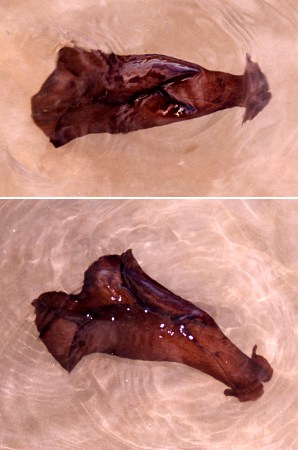
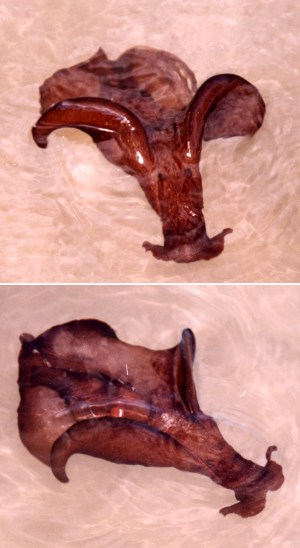
Dear Job,
Thanks for the photos and your observations. It is nice to get a series of photos showing the swimming action. This is Aplysia fasciata, a large Sea Hare found on the Atlantic and Mediterranean coasts of Europe. If you have a look at some of the earlier messages, which are below yours on this page, you'll see that it is has been seen a number of times in large numbers, sometimes swimming, in Portugal, Greece and southern France. I have discussed there some of the reasons Sea Hares are often found in large numbers, often washing up and dying on beaches.
Best wishes,
Bill Rudman
Aplysia fasciata swimming
November 7, 2002
From: Joao Pedro Tojal Silva
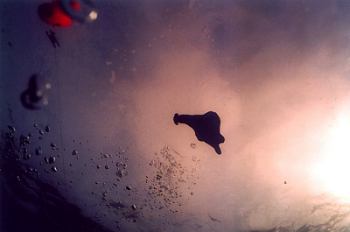
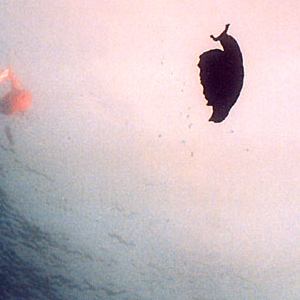
Dear Bill,
Here are some more photos of an Aplysia fasciata swimming. It was swimming near the surface (1-2m deep) in Baleal, Portugal, on the 1st of November 2002. The photos were taken in a wreck on the northeast of the peninsula (all the other photos I've sent you were from the southeast). Lots of individuals ere found there at that time.
All the best,
João Pedro
jpsilva@uwphotographer.net
Silva. J.P.T., 2002 (Nov 7) Aplysia fasciata swimming. [Message in] Sea Slug Forum. Australian Museum, Sydney. Available from http://www.seaslugforum.net/find/8368Thanks João Pedro,
They make a very artistic silhouette against the sky
Best wishes,
Bill Rudman
Re: Unknown egg mass from Turkey
October 19, 2002
From: Erwin Koehler
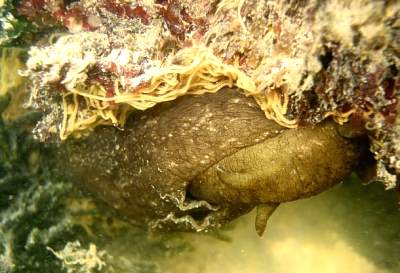
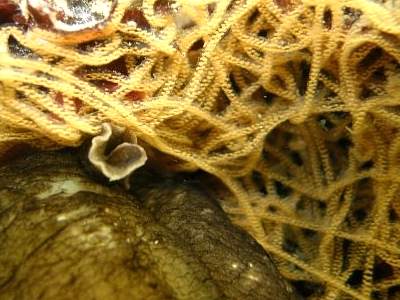
Dear Bill,
Paolo Rossi
[Email Paulreds@tin.it] sent some shots of Aplysia fasciata laying eggs and of the egg mass. I think they look like my shots from Turkey.
Data: size of the slug 12-15 cm
depth: 1-2 m
August 2002
Pesaro, Italy, divesite "Baia Flaminia"
Photo: Antidio & Paolo Rossi
Erwin
Erwin@medslugs.de
Koehler, E., 2002 (Oct 19) Re: Unknown egg mass from Turkey. [Message in] Sea Slug Forum. Australian Museum, Sydney. Available from http://www.seaslugforum.net/find/8159Dear Erwin,
As I said before, your egg mass from Turkey certainly could be from an Aplysia, but it is difficult to be sure without a good knowledge of the local fauna.
Cheers,
Bill Rudman
Re: Swimming Slug from Greece
August 6, 2002
From: George Sherman
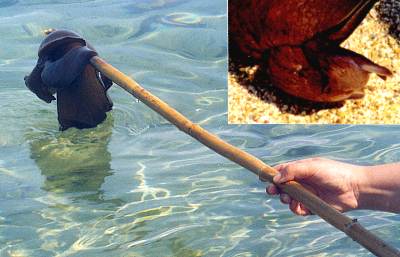
Dear Dr. Rudman:
Thank you for posting my earlier letter and for your tentative identification of my slug as a Sea Hare, probably Aplysia fasciata. My slug does look a lot like the photos of Xavier's 'sea bat' that you posted on 10 July 2002 and the photo of the Aplysia fasciata in the Factsheet. However, there are some differences in shape. Moreover, I saw only one pair of tentacles. So I am sending copies of the photos I have of the animal to you by snail mail just in case it is something different. Also, I'd like to correct an error I made in my original letter. I said that the slug was out of water for about 5 minutes without ill effects, but my fiancee pointed out to me that the boys had replaced it into the water while I was gone looking for a knife to cut off the fishing line around its neck. It was probably out of the water less than 2 minutes.
Sincerely,
George Sherman
gcsherman1@aol.com
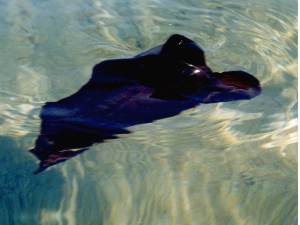
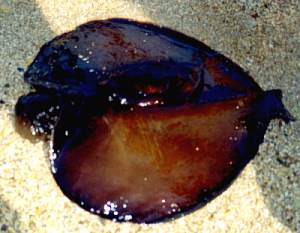
Dear George,
Definitely an Aplysia, and almost certainly A. fasciata. I guess the reason the large oral tentacles, alongside the mouth, are not very obvious, for that matter why the whole head is not very obvious, is because it is in some distress. With fishing line around its 'neck' it is trying to contract its head which only ends up making it more swollen [see inset - upper photo]. Sea Hares can survive out of water for some hours if they get stranded at low tide, as long as they are out of the direct sunlight, so being out of the water a couple of minutes would be no great trial.
The lower right photo shows it out of water with the large swimming parapodial flaps extended out on each side of the body.
Best wishes,
Bill Rudman.
Swimming slug? from Greece
July 13, 2002
From: George Sherman
Dear Dr. Rudman:
While on vacation in Greece, my fiancée and I had a fascinating encounter with a sea animal which I now believe must have been some kind of sea slug. It happened on June 17, 2002 at a sandy beach in the little town of Pylos on the Mediterranean in the most south-western portion of the Peloponissos peninsula. It was in the morning with very few people at the beach and a very smooth water surface with excellent visibility. We were standing just outside of the water at its very edge, when we notice something swimming slowly towards us about 15 or 20 yards out. A small portion of it remained out of the water and on either side of that, small portions of it periodically and simultaneously lifted up above the water surface and then back down again. I thought that it was some kind of ray swimming as if flying with broad wings. But when the creature got close to us, it was obviously neither a ray or any other kind of fish. It did, indeed, swim like a ray and it was flat and roundish, but it had a long neck (perhaps 2 or 3 inches) sticking out directly in front of it with a head slightly larger in diameter than the neck. No eyes, ears, nose, or mouth were visible, but it had two tentacles sticking out forward from the top, front of the head, which reminded me of the "antennae" on the heads of snails. These were the only tentacles it had. The color was a nearly uniform dark brown. Its motion was slow but steady in direction, taking perhaps a minute or two to travel the 15 or 20 yards. It came directly up to our feet and stopping there in about two inches of water for about 30 seconds to a minute. While there, it lifted its head up out of the water and banged it on the sand at the water's edge several times. Then it turned around and swam back out. When I pointed it out to a waiter in a outdoor plaza restaurant overlooking the water, he said he had not seen one of these for many years. When I asked what it was, he said, "It is not the kind of fish that you eat."
It started heading towards some young boys and a teenage girl who where swimming in waist deep water. When we pointed the creature out to them in the water, it became clear that they had no idea what it was. They lifted it out of the water with a long stick and laid it on the sand. On the stick, it just hung down on both sides as if it had no bones. On the sand, it lay still, flattened out to about 1 or 2 inches thick, with its neck retracted to about 1 inch and its tentacles barely visible. In this position, its main body was shaped like the symbol used to represent a heart. The heart was about 12 to 14 inches high and almost as much across in the widest part. The neck stuck out of the indentation at the top of the heart. There was a small flat (horizontal) tail at the bottom point of the heart. In the central area of the heart, was a large, irregular, kind of gelatin mass sticking up about a half inch or more above the otherwise smooth surface. (I believe that this is what stuck up out of the water when it was swimming.) The boys petted it with their hands all over its flat back without any unpleasant experience. We found a fishing line wrapped moderately tightly around its neck which we cut off with a knife. It was out of the water perhaps about 5 minutes without apparent ill effects. When we placed the animal back in the water, it released a very small amount of a milky substance which seemed to appear from underneath toward the rear. It then swam over to some large, partially submerged boulders, and began rubbing the underside of its head on the vertical surfaces of the rock in what appeared to be a feeding activity. It was swimming all of the while without attaching itself to anything.
We pointed this creature out to several passing Greeks and described it in detail to several locals. No one had any ideas about what it might be.
I have several very clear photos of it, one on the sand, two of it in the water at our feet with its tentacles out, two while it is draped over the stick, and two while it is swimming on the water surface quite a ways out. If you would like, I will send them to you by "snail" mail.
I would appreciate any comments you can give about what this must be. Until I found your forum, I was very baffled. I had ruled out sea slugs in my mind because it wasn't crawling on anything. The swimming and its shape (apart from the neck and head) made it seem like a fish, but it obviously was not.
Thanks for your help. Let me know it you want me to mail copies of the photos.
George Sherman
gcsherman1@aol.com
Sherman, G., 2002 (Jul 13) Swimming slug? from Greece. [Message in] Sea Slug Forum. Australian Museum, Sydney. Available from http://www.seaslugforum.net/find/7540Dear George,
I suspect your animal is a Sea Hare, and most probably Aplysia fasciata. Have a look at Xavier's recent message with photos of a swimming A. fasciata from southern France. Most Sea Hares can secrete both a reddish-purple and a milky white secretion. Have a look at the page on Aplysia brasiliana for photos of another species that swims.
If your animal doesn't look like these then perhaps you could send me copies of your photos.
Best wishes,
Bill Rudman
'sea-bat' from southwestern France
July 10, 2002
From: Xavier
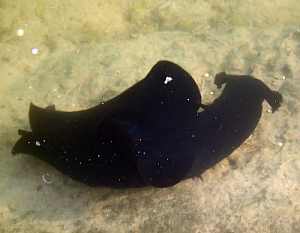
Dear SSF
Can you help identify the following, seen on our travels? I have been told by a fisherman neighbour that it is a sea-slug, and have arrived at your site after some unsuccessful searches elsewhere on the net.
Location: South West France, in a marine lake (salt-water, tidal). Seen from the bank, in the shallows at the edge of the lake, there being sufficient depth for it to 'swim'.
Pitch velvety black all over, about 30 to 35 cm long and about 10 or 12 cm diameter at thickest part. Mainly cylindrical body tapering to an approximately point at the tail. Small pointed projections at various points along body. Head: hammer-shaped with 'frilly' undulating edge at front (mouth?). 'Wings': a wide (maybe 15 cm in places) 'skirt' that appeared to encircle most of the 'waist' (that is, half way between head and tail) of the creature. Continually undulating when animal was still, then used in co-ordinated fashion both 'sides' of the body to propel the animal, very much as if flying with undulating wings though the water.
(Sorry, the pictures are not wonderful - it was below the water and I was above!)
Xavier
xavier@abelard.org
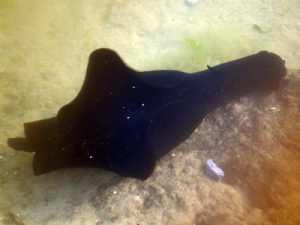
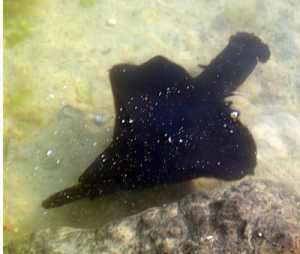
Dear Xavier,
Your 'sea bat' is indeed a sea slug and more particularly a Sea Hare, most probably Aplysia fasciata. Have a look at my reply to Hans Rothauscher's message from southern France for further information on Sea Hares and their swimming.
Best wishes,
Bill Rudman
Aplysia fasciata from Portugal
June 28, 2002
From: João Pedro Silva
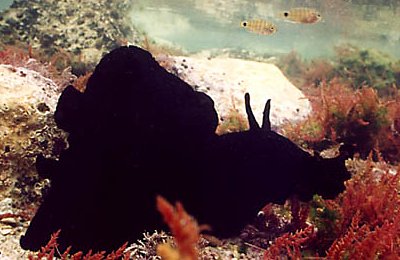
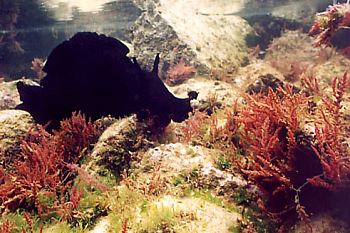
Dear Bill,
Here are two photos of Aplysia fasciata I took at Baleal, western Portugal earlier this month. It was longer than 40 cm!, and the photos were taken in a large rock pool during the low tide.
All the best,
João Pedro
joao.tojal.silva@novabase.pt
Silva, J.P., 2002 (Jun 28) Aplysia fasciata from Portugal. [Message in] Sea Slug Forum. Australian Museum, Sydney. Available from http://www.seaslugforum.net/find/7360Thanks João Pedro,
Bill Rudman
Aplysia fasciata from Portugal
December 15, 2001
From: Joao Pedro Silva

Dear Bill,
In August I took an entire film thinking it was 400ASA.. but it actually was 100ASA. I took it to a friend of mine who is a professional photographer to see if he could do something abaout it. Yesterday he finally brought me the photos. I had completely forgotten what subjects were shot and was happy to see most of the photos were of two Aplysia fasciata (one found swimming and the other on the bottom). The photos were taken in Baleal (Portugal) between 2 and 3 meters deep.
PS: I've added these on my web site at http://jpsub0.tripod.com
Best regards,
João Pedro Silva
jpsilva@infordesporto.pt
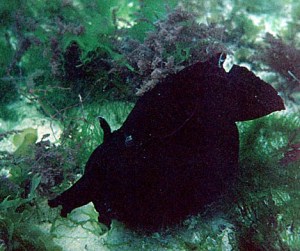
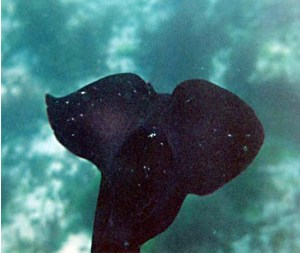
Dear João,
Thanks for these photos. Your website is looking good,
Best wishes,
Bill Rudman
Mass Congregation of Aplysia fasciata
February 23, 2001
From: Hans Rothauscher
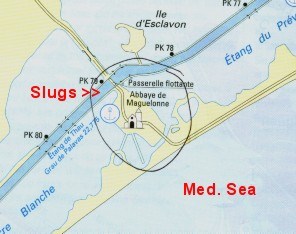
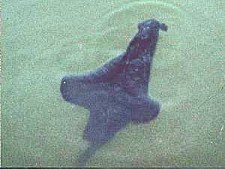
In June 2000 we saw masses of seahares [Aplysia fasciata] on the 'Canal du Rhône à Sète' in southern France, drifting with the current towards the Étang de Thau. They swam actively, grazed from rocks and the bottom of our boat. Next day they were gone.
The Canal, an extension of the Little Rhône, runs as an inland waterway along the coast through large shallow saltlakes and marshes. It is connected with the lakes through many floodgates. It has quite a current and I don't believe that it is the normal habitat of the seahares. I rather think that they normally live in the lakes.
Any suggestions as to what caused the temporary gathering? We believe that the animals were on their way to a mass marriage, probably in the Étang de Thau. This happened 2 days before the full moon, and we know that many invertebrates have such fixed annual reproduction "appointments".
Hans Rothauscher
http://home.t-online.de/home/rothauscher/
Rothauscher@t-online.de
Rothauscher, H., 2001 (Feb 23) Mass Congregation of Aplysia fasciata. [Message in] Sea Slug Forum. Australian Museum, Sydney. Available from http://www.seaslugforum.net/find/3856Dear Hans,
Thanks for the message. Finding large 'swarms' of Sea Hares is indeed an interesting experience, and it has been observed throughout the world with different species. The general feeling is that these 'swarms' are not migrations. Have a look at the messages on the Aplysia brasiliana page, where there are many reports of 'swarms' in Florida. Also have a look at the Mass Mortality page for more information and examples. In brief, these swarms appear to be the result of synchronised life cycles. Since they all spawn about the same time, large numbers reach maturity about the same time. You will certainly find many of the swarm mating, often in chains of 3 or 4, but they haven't formed the swarm to mate, they are mating because they are all close together.
Concerning your suggestion of 'mass marriages'. Many marine invertebrates do have mass reproductive events which are often synchronised by the phases of the moon. However these usually occur in groups of invertebrates [corals, polychaete worms, sea urchins] which are either unable to move, or do not mate or copulate. To reproduce they simply release their eggs and sperm in to the sea. The sea is a very big place, so by synchronising their spawning, these animals greatly improve the chances od a sperm finding, and fertilising, an egg of the same species. Not quite as romantic as the idea of synchronised mass marriages, but it works.
Best wishes,
Bill Rudman
